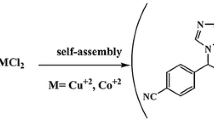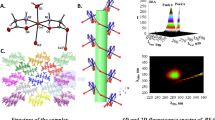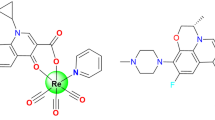Abstract
Zn(II) complexes with norfloxacin (NOR) in the absence or in the presence of 1,10-phenanthroline (phen) were obtained and characterized. In both complexes, the ligand NOR was coordinated through a keto and a carboxyl oxygen. Tetrahedral and octahedral geometries were proposed for [ZnCl2(NOR)]·H2O (1) and [ZnCl2(NOR)(phen)]·2H2O (2), respectively. Since the biological activity of the chemicals depends on the pH value, pH titrations of the Zn(II) complexes were performed. UV spectroscopic studies of the interaction of the complexes with calf-thymus DNA (CT DNA) have suggested that they can bind to CT DNA with moderate affinity in an intercalative mode. The interactions between the Zn(II) complexes and bovine serum albumin (BSA) were investigated by steady-state and time-resolved fluorescence spectroscopy at pH 7.4. The experimental data showed static quenching of BSA fluorescence, indicating that both complexes bind to BSA. A modified Stern–Volmer plot for the quenching by complex 2 demonstrated preferential binding near one of the two tryptophan residues of BSA. The binding constants obtained (K b ) showed that BSA had a two orders of magnitude higher affinity for complex 2 than for 1. The results also showed that the affinity of both complexes for BSA was much higher than for DNA. This preferential interaction with protein sites could be important to their biological mechanisms of action. The analysis in vitro of the Zn(II) complexes and corresponding ligand were assayed against Trypanosoma cruzi, the causative agent of Chagas disease and the data showed that complex 2 was the most active against bloodstream trypomastigotes.









Similar content being viewed by others
References
Appelbaum PC, Hunter PA (2000) The fluoroquinolones: past, present and future perspectives. Int J Antimicrob Agents 16:5–15
Arounaguiri S, Easwaramoorthy D, Ashokkumar A, Dattagupta A, Maiya BG (2000) Cobalt(III), nickel(II) and ruthenium(II) complexes of 1,10-phenanthroline family of ligands: DNA binding and photocleavage studies. Proc Indian Acad Sci 112:1–17
Batista DGJ da, Silva PB da, Stivanin L, Lachter DR, Silva RS, Felcman J, Louro SRW, Teixeira LR, Soeiro M de NC (2011) Co(II), Mn(II) and Cu(II) complexes of fluoroquinolones: synthesis, spectroscopical studies and biological evaluation against Trypanosoma cruzi. Polyhedron 30:1718–1725
Batista DGJ, Pacheco MGO, Kumar A, Branowska D, Ismail MA, Hu L, Boykin DW, Soeiro MNC (2009) Biological, ultrastructural effect and subcellular localization of aromatic diamidines in Trypanosoma cruzi. Parasitology 137:251–259
Batista DGJ, Silva PB, Garcia LS, Lachter DR, Silva RS, Felcman J, Louro SRW, Teixeira LR, Soeiro MNC (2011) Co(II), Mn(II) and Cu(II) complexes of fluoroquinolones: synthesis, spectroscopical studies and biological evaluation against Trypanosoma cruzi. Polyhedron 30:1718–1725
Coura JR, Dias JC (2009) Epidemiology, control and surveillance of Chagas disease: 100 years after its discovery. Mem Inst Oswaldo Cruz 104:31–40
Cox PJ, Psomas G, Bolos CA (2009) Characterization and DNA-interaction studies of 1,1-dicyano-2,2-ethylene dithiolate Ni(II) mixed-ligand complexes with 2-amino-5-methyl thiazole, 2-amino-2-thiazoline and imidazole. Crystal structure of [Ni(i-MNT)(2a-5mt)(2)]. Bioorg Med Chem 17:6054–6062
Daliry A, da Silva PB, da Silva CF, Batista MM, de Castro SL, Tidwell RR, Soeiro MNC (2009) In vitro analyses of the effect of aromatic diamidines upon Trypanosoma cruzi. J Antimicrob Chemother 64:747–750
Deacon GB, Phillips RJ (1980) Relationships between the carbon–oxygen stretching frequencies of carboxylato complexes and the type of carboxylate coordination. Coord Chem Rev 33:227–250
Dhar S, Nethaji M, Chakravarty AR (2005) Effect of charge transfer bands on the photo-induced DNA cleavage activity of [1-(2-thiazolylazo)-2-naphtholato]copper(II) complexes. J Inorg Biochem 99:805–812
Dias JC (2007) Southern cone Initiative for the elimination of domestic populations of Triatoma infestans and the interruption of transfusional Chagas disease. Historical aspects, present situation and perspectives. Mem Inst Oswaldo Cruz 102:11–18
Dorofeev VL (2004) Infrared spectra and the structure of drugs of the fluoroquinolone group. Pharm Chem J 38:693–697
Dudev T, Lim C (2000) Tetrahedral vs. octahedral Zn2+ complexes with ligands of biological interest: a DFT/CDM study. J Am Chem Soc 122:11146–11153
Emami S, Shafiee A, Foroumadi A (2005) Quinolones: recent structural and clinical developments. Iran J Pharm Res 3:123–136
Gao F, Yang P, Xie J, Wang H (1995) Synthesis, characterization and antibacterial activity of novel Fe(III), Co(II), and Zn(II) complexes with norfloxacin. J Inorg Biochem 60:61–67
Geary WJ (1971) The use of conductivity measurements in organic solvents for the characterization of coordination compounds. Coord Chem Rev 7:81–122
Hooper DC (1999) Mechanisms of fluoroquinolone resistance. Drug Resist Updates 2:38–55
Hulme EC, Trevethick MA (2010) Ligand binding assays at equilibrium: validation and interpretation. Br J Pharmacol 161:1219–1237
Kamat BP (2005) Study of the interaction between fluoroquinolones and bovine serum albumin. J Pharm Biomed Anal 39:1046–1050
Lakowicz JR (2004) Principles of fluorescence spectroscopy, 2nd edn. Springer, New York
Lakowicz JR, Weber G (1973) Quenching of fluorescence by oxygen: probe for structural fluctuations in macromolecules. Biochemistry 12:4161–4170
Luiz FCL, Garcia LS, Goes Filho LS, Teixeira LR, Louro SRW (2011) Fluorescence studies of gold(III)–norfloxacin complexes in aqueous solutions. J Fluoresc 21:1933-1940
Marmur J (1961) A procedure for the isolation of deoxyribonucleic acid from microorganisms. J Mol Biol 3:208–218
Martins DA, Gouvea LR, Gama JBD da, Silva PB da, Louro SR, Soeiro M de NC, Teixeira LR (2012) Copper(II)–fluoroquinolone complexes with anti-Trypanosoma cruzi activity and DNA binding ability. BioMetals 25:951–960
Meirelles MN, de Araujo-Jorge TC, de Souza W (1982) Interaction of Trypanosoma cruzi with macrophages in vitro: dissociation of the attachment and internalization phases by low temperature and cytochalasin B. Z Parasitenkd 68:7–14
Park H-R, Kim TH, Bar K-M (2002) Physicochemical properties of quinolone antibiotics in various environments. Eur J Med Chem 37:443–460
Patrick GL (1995) An introduction to medicinal chemistry. Oxford University Press, New York
Perrin DD, Dempsey B (1974) Buffers for pH and metal ion control. Chapman and Hall, New York
Pyle AM, Rehmann JP, Meshoyrer R, Kumar CV, Turro NJ, Barton JK (1989) Mixed-ligand complexes of ruthenium(II): factors governing binding to DNA. J Am Chem Soc 111:3051–3058
Refat MS (2007) Synthesis and characterization of norfloxacin-transition metal complexes (group 11, IB): spectroscopic, thermal, kinetic measurements and biological activity. Spectrochim Acta A 68:1393–1405
Refat MS, Mohamed GG, de Farias RF, Powell AK, El-Garib MS, El-Korashy SA, Hussien MA (2010) Spectroscopic, thermal and kinetic studies of coordination compounds of Zn(II), Cd(II) and Hg(II) with norfloxacin. J Therm Anal Calorim 102:225–232
Sadeek SA (2005) Synthesis, thermogravimetric analysis, infrared, electronic and mass spectra of Mn(II), Co(II) and Fe(III) norfloxacin complexes. J Mol Struct 753:1–12
Saha DK (2004) A novel mixed-ligand antimycobacterial dimeric copper complex of ciprofloxacin and phenanthroline. Bioorg Med Chem Lett 14:3027–3032
Shaikh AR, Giridhar R, Yadav MR (2007) Bismuth–norfloxacin complex: synthesis, physicochemical and antimicrobial evaluation. Int J Pharm 332:24–30
Silva CF, Batista DG, Oliveira GM, Souza EM, Hamer ER, da Silva PB, Daliry A, Araujo JS, Brito C, Rodrigues ACM, Liu Z, Farahat AA, Kumar A, Boykin D, Blader I, Soeiro MNC (2012) In vitro and in vivo investigation of the efficacy of arylimidamide DB1831 and its mesylated salt form—DB1965—against Trypanosoma cruzi infection. PLoS One 7:30356
Skyrianou KC, Efthimiadou EK, Psycharis V, Terzis A, Kessissoglou DP, Psomas G (2009) Nickel–quinolones interaction. Part 1—nickel(II) complexes with the antibacterial drug sparfloxacin: structure and biological properties. J Inorg Biochem 103:1617–1625
Skyrianou KC, Perdih F, Turel I, Kessissoglou DP, Psomas G (2010) Nickel–quinolones interaction. Part 3—nickel(II) complexes of the antibacterial drug flumequine. J Inorg Biochem 104:740–749
Soeiro MNC de, Castro SL de (2011) Screening of potential anti-Trypanosoma cruzi candidates: in vitro and in vivo studies. Open Med Chem J 5:21–30
Wang Y, Zhang H, Zhang G, Tao W, Tang S (2007) Interaction of the flavonoid hesperidin with bovine serum albumin: a fluorescence quenching study. J Lumin 126:211–218
Yesilel OZ, Soylu MS, Olmez H, Buyukgungor O (2006) Synthesis and spectrothermal studies of vitamin B13 complexes of cobalt(II) and nickel(II) with 4-methylimidazole: crystal structure of [Ni(HOr)(H2O)(4-Meim)3]2·5H2O. Polyhedron 25:2985–2992
Acknowledgments
The present study was supported by Fundação de Amparo a Pesquisa do Estado de Minas Gerais (FAPEMIG), Fundação de Amparo a Pesquisa do Estado do Rio de Janeiro (FAPERJ), Conselho Nacional de Desenvolvimento Científico e Tecnológico (CNPq) and PDTIS/Fiocruz.
Author information
Authors and Affiliations
Corresponding author
Rights and permissions
About this article
Cite this article
Gouvea, L.R., Martins, D.A., da Gama Jean Batista, D. et al. Norfloxacin Zn(II)-based complexes: acid base ionization constant determination, DNA and albumin binding properties and the biological effect against Trypanosoma cruzi . Biometals 26, 813–825 (2013). https://doi.org/10.1007/s10534-013-9661-z
Received:
Accepted:
Published:
Issue Date:
DOI: https://doi.org/10.1007/s10534-013-9661-z




